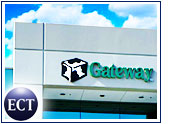
After its successful push into the consumer electronics space in 2003, Gateway’s branded introduction to the professional services space is problematic, according to Yankee Group SMB senior analyst Mike Lauricella. Specifically, Lauricella expresseddoubts about Gateway’s ability to tap into the large enterprise market.
“They may find some success in the very low end of the SMB market,” he told the E-Commerce Times. “I doubt they will see much success with firms that have greater than 20 employees.”
However, Gateway’s reason for launching enterprise services seems clear: Lauricella noted that the struggling company’s revitalization push cannot rely on consumer electronics alone as margins tighten and competition increases.
Since Gateway launched its consumer electronics initiative, Hitachi and Dell also have jumped on that bandwagon, and heavyweights Sony, Philips and Panasonic are starting to enter the melee, wielding their own formidable brand share.
IBM Spurred Service
Gateway’s new professional-services initiative stems from its relationship with IBM Global Services, which provides expertise and a solid reputation in IT professional services. However, the move is quite a departure for Gateway, which has established a reputation solely as a hardware manufacturer.
Now, Gateway OS Migration services is targeting midsize businesses that seek greater business effectiveness and improved network security. At the outset, companies thatrun Windows NT 4.0, Novell, Red Hat Linux or Unix can contract with Gateway to foster a smoother migration to Microsoft Windows Server 2003 or a more current e-mail system, for example.
100-Seat Floor
IDC vice president for SMB research Raymond Boggs is somewhat more bullish about Gateway’s prospects, saying the new services meet the needs of companies that are either too large for simple solutions or too small for extensive million-dollar implementations.
“Operating systems are not just for the large corporations. I see this product having natural sales appeal for smaller businesses with a floor at 100 seats,” Boggs told the E-Commerce Times.
“Previously, SMBs had been using the channel for OS implementations,” he added. “Having a single point of contact at Gateway will be useful.”
In addition to OS migration, Gateway plans to roll out server consolidation, network assessment and security consulting services in the next year. It is unclear at this stage what type of fees the company plans to charge or how the new initiatives will affect its bottom line. As part of its product introduction strategy, Gateway will not charge for initial assessments of OS migration work.
Healthy Consumer Strategy
Gateway was the first PC manufacturer to make the leap into the lucrative flat-panel TV market, as well as the digital camera and MP3 player markets, as a way to breathe life back into its struggling business. By using its low-cost base and direct retail model, the company was able to compete at a good price point for consumers while still enjoying healthy 8 percent to 15 percent profit margins. The effort proved fairly successful: In the past year, one-third of Gateway’s revenue came from its consumer-electronics business.
The company’s PC revenue, however, continues to struggle. Gateway no doubt is hoping to offset problems in this area through the addition of eMachines’ revenue, assuming its $234 million acquisition of that company closes.







































Social Media
See all Social Media